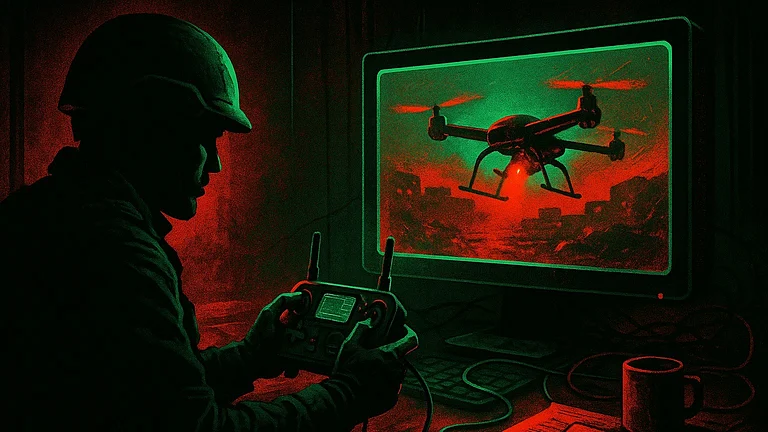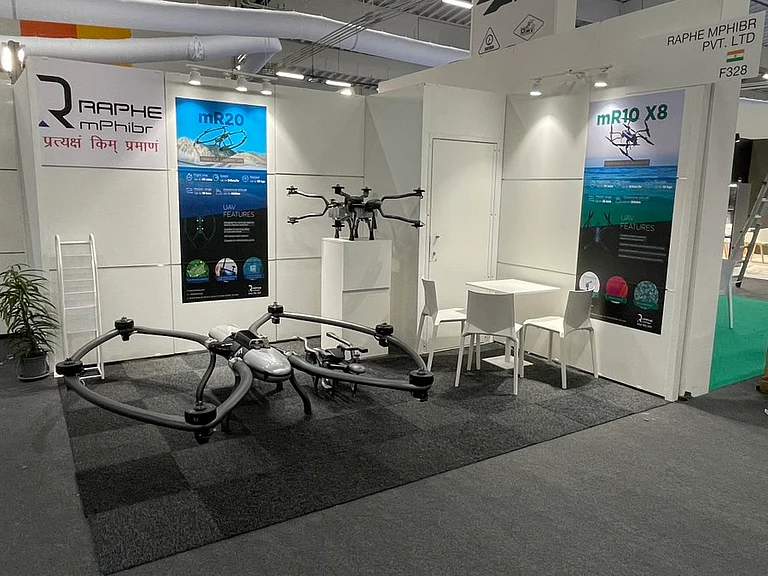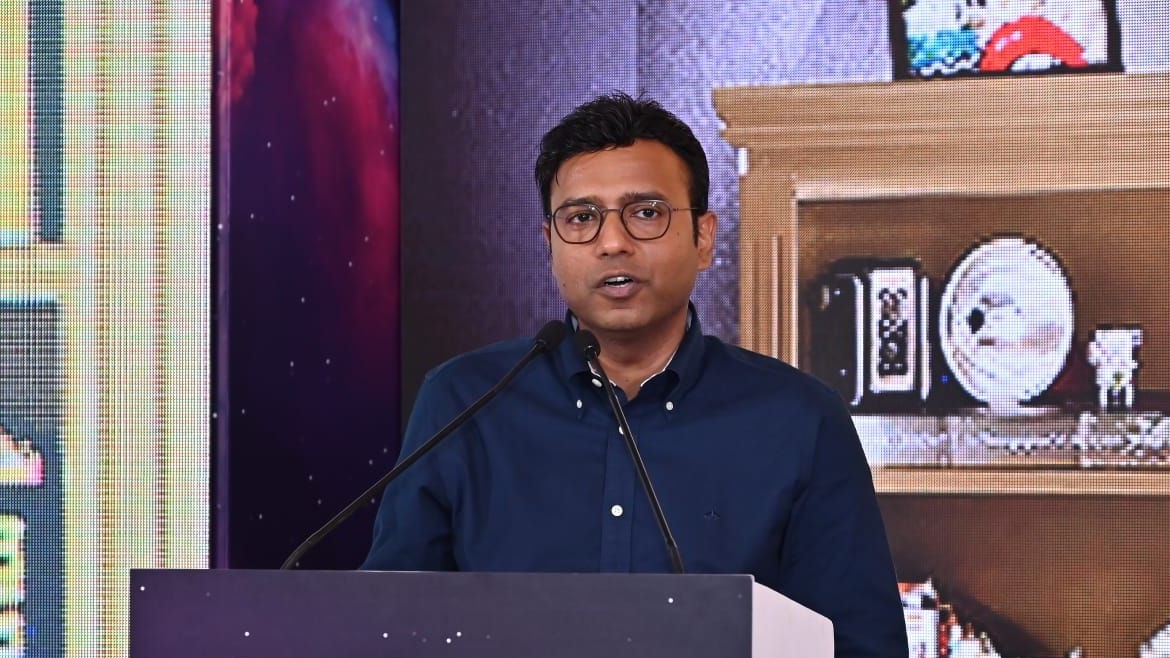
BotLab Dynamics, founded by IIT Delhi innovators Dr. Sarita Ahlawat, Tanmay Bunkar, and Anuj Barnwal, set out to build sovereign deep-tech drones at a time when India remained heavily dependent on foreign defence technology.
Despite early funding struggles, the team developed India’s first large-scale swarm drone system and delivered landmark shows, including the 1,000-drone Beating Retreat (2022) and the 5,500-drone world record display.
While BotLab has indigenised key electronics such as flight controllers, GPS modules, and RF systems, India still lacks domestic manufacturing for motors, propellers, and batteries, revealing persistent gaps in the deep-tech ecosystem.
Prime Minister Narendra Modi’s landmark ‘Make in India’ initiative is often credited with spreading awareness about the need for industrial self-sufficiency in India. However, for innovators like Anuj Kumar Barnwal, Tanmay Bunkar, and Dr. Sarita Ahlawat, this conviction runs deeper than any political slogan or government scheme. The three IITians were so convinced in their early years about the need for India to build its own deep-tech that they started BotLab Dynamics, a pioneer in drone warfare and technology.
BotLab was founded in 2016, a year of converging paths at IIT Delhi. Dr. Sarita had just returned from the U.S., where she spent nearly two years as a Research Affiliate with the New York State Department of Health. After coming back, she started working on 3D microscopy at IIT Delhi, when she met Tanmay and Anuj, who were completing their B.Tech.
The three soon realized that they all shared one conviction: India was dangerously dependent on foreign nations to meet its needs for high-tech devices, even to defend itself. Inspired by this shared interest, the trio decided to explore starting a deep-tech venture that would set the standards in defence technology, particularly in the emerging area of drone warfare.
As they dug deeper, they discovered an even starker picture in the defence sector: More than 80% of India’s requirements were dependent on foreign players, particularly Russia. That insight became their point of synergy. It was clear to all three that India needed technology that was not just assembled here, but conceived, designed, and built in India, for India.
Meanwhile, their individual journeys into technology had begun years earlier.
At a time when drones were barely recognised as a serious technology in India, Tanmay Bunkar had launched his first UAV into the air, and by 2014, he and his team were already working on a contract to deliver eight drones for the Delhi Police. On 18 July 2016, the trio formally incorporated BotLab Dynamics at the Technology Business Incubator Unit at IIT (Indian Institute of Technology) Delhi. That same year, the company achieved its first milestone by delivering heavy-lift drone systems to the Indian Agricultural Research Institute (IARI), beginning its journey in the field of indigenous high-performance UAVs.
The Early Years
The idea behind BotLab Dynamics was to leverage swarm technology that enables large groups of drones to fly autonomously and simultaneously while carrying out assigned tasks, such as forming precise patterns in the sky. They believed that drone swarms could transform defence operations, accomplishing tasks far more efficiently than competing technologies. Still, the concept of swarm drones was still relatively unknown in India, which made their vision both ambitious and ahead of its time.
Moreover, the trio had the vision, the backing of IIT Delhi, and a clear understanding of the technology, but they lacked a key ingredient—funding.Bunkar had relied heavily on his family to find the funds for the startup, while Dr Sarita had contributed whatever savings she had brought back from the U.S..
“For nearly three years,” remembers Dr Sarita, “we kept the company afloat this way. But it was not easy. Government grants were not coming through, private investors were not ready to bet on deep tech, and our personal funds were draining slowly.”
Eventually, they secured a small grant from the Department of Science and Technology (DST) under the NIDHI (National Initiative for Developing and Harnessing Innovations) programme. Even then, it wasn’t enough to sustain the startup. The trio continued taking up side projects and other jobs simply to keep things running.
In addition, they adopted more practical strategies to reduce expenses. One of these was the shift to miniature drones while they perfected the technology, given the higher financial impact from losing larger systems. “Defence-grade drones cost around ₹1.5 lakh each, so losing even one would have been a major financial setback,” said Dr Sarita.
Around this time, Covid arrived as a blessing in disguise, giving them the time and space to quietly build the entire tech stack themselves. According to Bunkar, during those two years, they focused on building the core technology and eventually became the first in India to fly 50 drones together.
“We documented everything, posting updates and videos on LinkedIn, Facebook, everywhere. Then one of those videos went viral. The Ministry of Defence, whom we had met on a few occasions earlier, spotted it and invited us to conduct a demo,” he added.
From there, the company’s fortunes turned. It received an opportunity to build a 1,000-drone swarm, and the defence ministry stepped in with crucial support, facilitating funds, including both loans and equity. Thanks to the support, BotLab was able to build the 1,000 drones and deliver a landmark performance at the Beating Retreat ceremony on January 29, 2022 in the presence of the President and Prime Minister of India. Since then, BotLab has executed drone shows across India and abroad ranging from 5,500 drones at the Ambani pre-wedding to 3,500 drones at Rashtrapati Bhavan.
“We also set a world record for large-scale drone light shows in Vijayawada on October 22 with a 5,500-drone display. Our work has featured at the IPL, the Cricket World Cup, Tata product launches, and several other marquee events,” shared Dr Sarita. The company has been growing at around 26% every year, and hit revenue of ₹48.5 crore for the year ended March 2025.
The Challenges of Indigenisation
The core motivation behind starting BotLab Dynamics has been to develop sovereign technology and eventually manufacture the product in India. However, BotLab remains an outlier in the Indian drone ecosystem. Data from the Global Trade Research Initiative (GTRI) shows that India remains critically dependent on China for most of its technology goods. The country imported total goods worth $101.8 billion from China in FY2024, up from $76.4 billion in 2018. Nearly all of this, or about 98.5%, comprised industrial products, including drones and components.
Still, BotLab did not want to do what most of its competitors were doing. Instead, they designed their own electronic circuits and built them out using locally sourced components. Their flight controllers, motor controllers, and GPS modules are all engineered and built in-house. Although it would have been easier to use off-the-shelf parts, BotLab believes that its strategy of building them from scratch is critical to India’s national security.
“For us, it’s been nine years of building technology, and we are very clear about what we develop in-house. We’re now working on RF (Radio Frequency) as well. You need RF modules for communication, and only a handful of companies in India make them so we built our own. We are also manufacturing our own antennas. In our latest drone, every component from the downlink to the uplink is designed by us,” said Dr. Sarita.
Even the drone body is built inhouse, with the plastic shells molded by local vendors. “This helps us keep the drone extremely lightweight. We work with vendors in Manesar and Faridabad who support the assembly,” added Bunkar.
However, there are still crucial components for which the company has to depend on imports: motors, propellers, and batteries. Complete indigenisation requires a domestic ecosystem to manufacture these components, but “the ecosystem for these components just doesn’t exist yet,” according to the founders.
Meanwhile, there are also those who believe that 100% indigenisation is impractical, such as Manan Anand, Investment Associate at growX Ventures, which specialises in deep-tech investments in defence and aerospace. “You may master all the know-how and build every capability, but you will still import lithium-ion cells from Africa. So while technological expertise can be fully indigenous, some level of global dependence is not only normal but healthy,” he said.
The Road Ahead
More than technology, the bigger challenge for Indian deep-tech companies is achieving profitability and mastering a viable business model, something that is possible only with sustained investment in R&D, strong market demand, and a large market for deep-tech products such as drones.
To achieve financial sustainability, BotLab is focused on exploring alternate avenues of commercialisation for its technology, rather than just scaling up its output. For example, it has developed a drone-flight simulator and is developing larger drones that can fly a few hundred kilometres. It is also integrating computer vision for autonomous target detection and identification, which can increase the drone’s appeal to defence clients.
Besides achieving financial profitability and technological self-sufficiency, the company also faces other challenges, particularly lack of testing infrastructure.
“There is a shortage of testing facilities. Anyone building drones should have access to standardised testing infrastructure. When you don’t have much money in the early days, these facilities make a huge difference,” said Dr. Sarita.
According to Lt Gen Rahul R Singh, AVSM, VSM, Deputy Chief of Army Staff (CD&S), Indian Army, the Ministry of Defence is working on a comprehensive drone framework aimed at addressing operational challenges and streamlining the testing process.
He said the upcoming framework will prioritise domestic production, identifying and mitigating vulnerabilities, and placing testing at the centre so that drone startups can scale more efficiently.
“Right now, a lot of time goes into testing and validation. If a vendor provides a system that is already thoroughly tested and ready for induction, why should we spend additional time re-testing it?” he added.
































